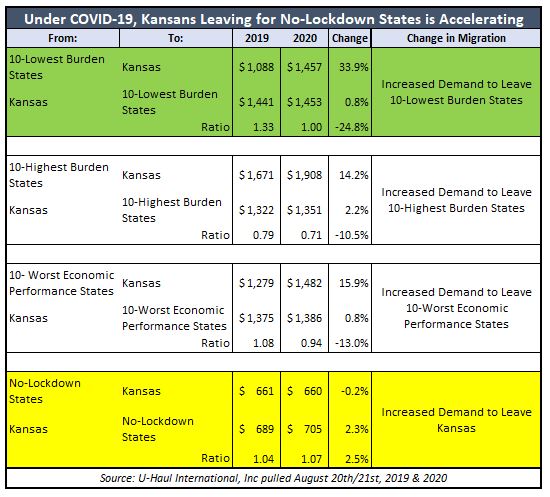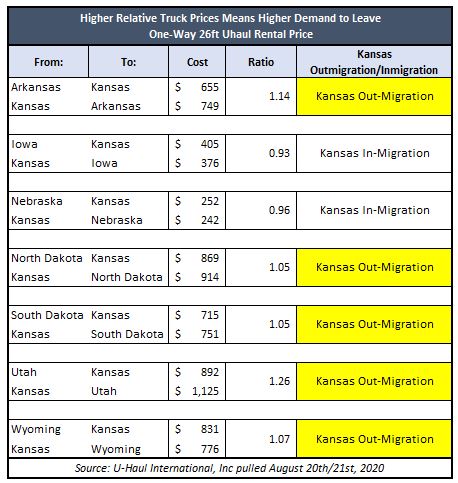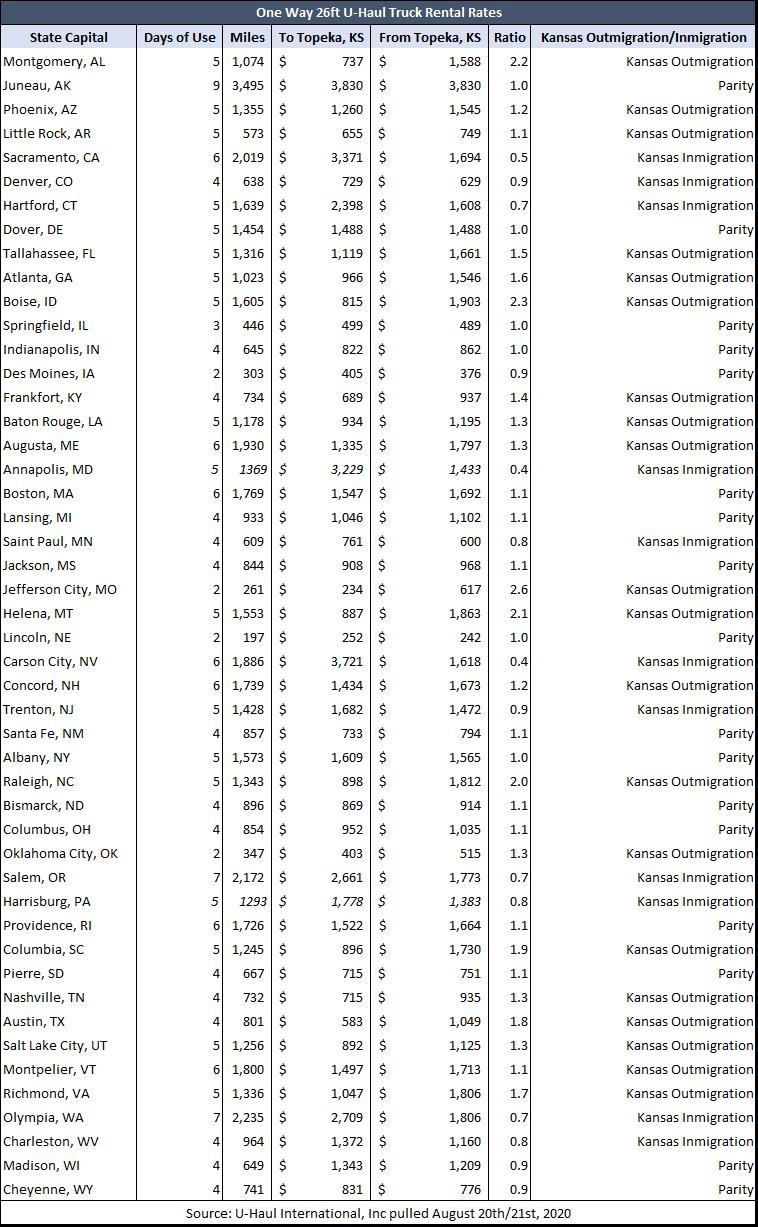Interstate migration is an honest perspective of how Americans view the economic opportunities in their state. Patterns and trends of Americans moving serve as evidence that people prefer states that are economically dynamic, vibrant, with plenty of opportunities. Moreover, this relationship doesn’t fade but rather, becomes more prominent under COVID-19. Updated research on moving van prices shows that more Kansans are relocating to states that didn’t impose mandates and shutdowns in 2020.
The official measure of interstate migration comes from the U.S. Census Bureau. However, that metric has a 2-year lag and is something KPI routinely covers. Luckily, analyzing U-Haul prices can give an up to date account on migration patterns across the country.
How? U-Haul’s one-way truck rental rates are a market-adjusting tool comparing the desire to relocate among any two cities, like UBER’s surge pricing. When the demand to relocate to an area is low, U-Haul lowers trucks’ prices to boost rentals. When the demand to relocate to an area is high, U-Haul raises prices to slow rentals. U-Haul’s need to maintain truck inventories across America creates a unique opportunity to tell analysts where Americans are moving without waiting for Census data. Therefore, we considered the price of a 26 ft long truck (U-Haul’s recommendation for a 3-4-bedroom home) between state capitols on the same days of the year. We assume that the price differences between state capitols represent price differences between the entirety of the two states. The table below summarizes U-Haul rental truck prices between Kansas and some different state groups.
 In the first section of the table (highlighted in green), we recorded prices between the ten lowest burden states and Kansas. In 2019, prices leaving Kansas for low burden states were 33% higher than the reverse trip. This 33% premium means the demand to leave Kansas is higher than the demand to leave low burden states. However, in 2020, that price difference disappeared, suggesting that more folks want to leave low burden states. Yet if we look closer (see full table at the end of the post), we’d find people are leaving the no-income-tax state Nevada. Nevada, a state heavily dependent on tourism, sees droves of people go for other opportunities, likely related to COVID-19.
In the first section of the table (highlighted in green), we recorded prices between the ten lowest burden states and Kansas. In 2019, prices leaving Kansas for low burden states were 33% higher than the reverse trip. This 33% premium means the demand to leave Kansas is higher than the demand to leave low burden states. However, in 2020, that price difference disappeared, suggesting that more folks want to leave low burden states. Yet if we look closer (see full table at the end of the post), we’d find people are leaving the no-income-tax state Nevada. Nevada, a state heavily dependent on tourism, sees droves of people go for other opportunities, likely related to COVID-19.
While for some states like Nevada, migration patterns reversed over the year. For other states, migration accelerated. The last column in the first table summarizes the change in migration flows. More Americans relocate to Kansas, fleeing high tax and worse performing states. On the flip side, more Kansans are relocating to states that didn’t lockdown. In 2019, prices to leave Kansas for no-lockdown states were 4% higher than the reverse trip. In COVID 2020, this differential grew even further.
 The adjacent table breaks down relative U-Haul prices between Kansas and no lockdown states. As an example, it costs $655 to rent a truck and move from Arkansas to Kansas. However, making the reverse trip is 14% more expensive. In other words, more people want to leave Kansas for Arkansas than the other way around. In fact, out of the seven no-lockdown states, Kansas is losing residents to 5 of them.
The adjacent table breaks down relative U-Haul prices between Kansas and no lockdown states. As an example, it costs $655 to rent a truck and move from Arkansas to Kansas. However, making the reverse trip is 14% more expensive. In other words, more people want to leave Kansas for Arkansas than the other way around. In fact, out of the seven no-lockdown states, Kansas is losing residents to 5 of them.
A report from HireAHelper shows that the COVID pandemic forced 15% of all interstate migration. Of those individuals, 37% moved because they couldn’t afford their housing due to job or income loss. Another 33% decided to shelter-in-place with their families. Another 6% said they moved for a destination with fewer restrictions due to COVID-19. Pew Research discovered similar findings, noting that 1 in 10 young adults moved due to the COVID-19 outbreak.
While many Americans decided to stay home amidst the COVID pandemic, it didn’t put a complete stop on all interstate migration. Data shows that for a sizeable number of Kansans, COVID was just another reason for them to leave the Sunflower State for better opportunities.






